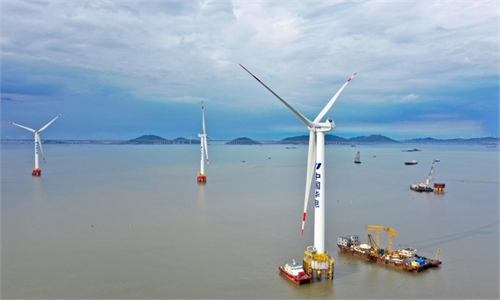Greenhouse gas emissions trading starts
China to introduce more financial derivatives later: analysts

Shanghai Environment and Energy Exchange Photo: cnsphoto
As China formally begins trading of greenhouse gas emissions rights, some analysts anticipate launch of financial derivatives related to the theme of carbon neutrality, including carbon futures and carbon options in the future.
But introduction of the financial products are unlikely until the current spot market evolves to be active and stable enough for ushering in those financial derivatives.
China's long-anticipated greenhouse gas emissions trading system opened on Friday, with 4.1 million tons of carbon dioxide quotas worthy of 210 million yuan ($32 million) traded. By the end of the trading session, the carbon trade price closed at 51.23 yuan per ton, rising 6.73 percent.
China has established a national carbon market in 2017 on a trial basis, but it is until this year, after China has phased in a specific goal for carbon emissions peak and carbon neutrality goals, that the trading of carbon emission rights officially starts.
The first participants in the national carbon trading market included 2,200 power sector enterprises, with total carbon emissions of about 4 billion tons annually, according to government officials.
A group of Chinese power giants including the Huaneng Group and China National Petroleum Corporation participated in the market's trading on the first day, the Beijing-based Securities Times reported.
Although the market remains in its nascent stage considering trading volume and the richness of financial tools, the analysts anticipated that some related financial products or related services would be introduced soon.
One of the possible derivatives could be about carbon emissions trading rights. Recently, a representative from the policy research bureau under the China Banking and Insurance Regulatory Commission said that carbon emission rights could be used as an effective pledge and provide "pledge basis" for domestic banks to increase financing.
"We can explore the possibility (of the financial product) in this aspect," the person said.
Xi Junyang, professor at the Shanghai University of Finance and Economics, said that carbon pledge should be the first carbon related financial product to be implemented after launch of the carbon emission market in China.
"This should be a basic carbon financial product that is likely to be tested first in China," Xi told the Global Times. According to him, banks will allow companies to use their carbon emission allowances as a basis for loan pledging, which will be sold if they can't repay the loans.
The trend will strengthen banks and will tilt toward greener companies or companies that carry out carbon emission reduction effectively, experts say, to keep with government promotions and the international trend.
Apart from carbon pledges, experts noted that carbon futures will be introduced at some point in the future, although they said that obstacles for that goal remain significant.
Carbon futures trading have been adopted in some overseas markets. For example, both future contracts and quarterly future contracts are traded for European Union Allowance, the tradable unit under the European Union Emissions Trading Scheme.
However, experts cautioned that China could not directly copy the experience of some foreign countries, but should develop its own carbon futures market step by step.
Lin Boqiang, director of the China Center for Energy Economics Research at Xiamen University, said that in many overseas countries, the cost of carbon emissions is often transmitted to consumers by means of fluctuating electricity prices. In China, however, as electricity price is regulated by the government, there's often less motivation for electricity companies to engage in carbon trading.
"When price fluctuation is inactive for carbon trading, investors would be reluctant to apply financial tools to this field," Lin told the Global Times, adding that the 51.23-yuan carbon trade price on the first trading day is "relatively low".
Xi also said that the development of financial derivative market for carbon trading is plausible when the spot market is stable and active enough.
"Usually, price fluctuations on the futures market is much more intense compared with the spot market, and therefore regulators want to make sure that the spot market for carbon emission rights trading is mature, stable enough before considering futures trading," he said.
According to Xi, within the next few months it would be clear whether the transaction price on the Chinese carbon trade market is reasonable and stable, and if participation is active enough to usher in other financial products. In general, he predicted that it will take at least another year before carbon futures to be implemented in China.

